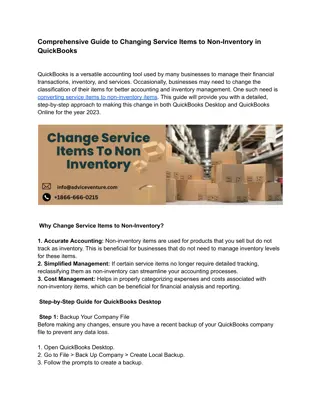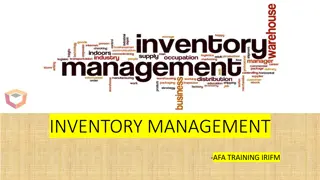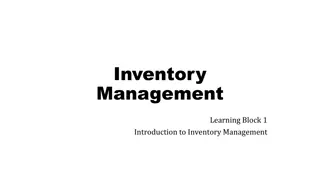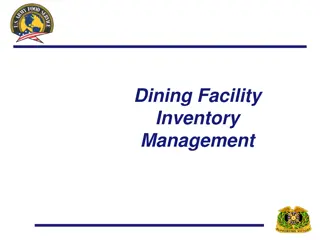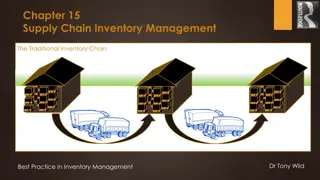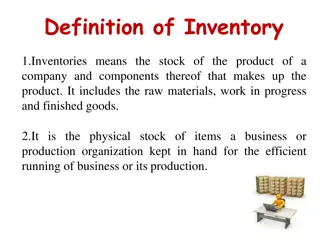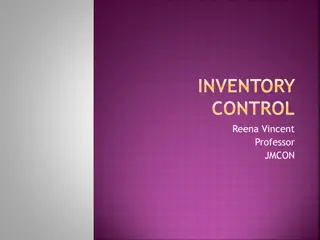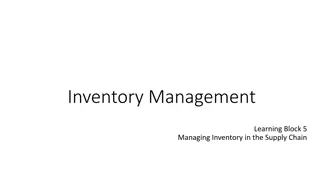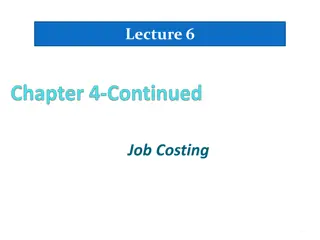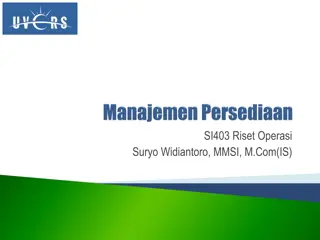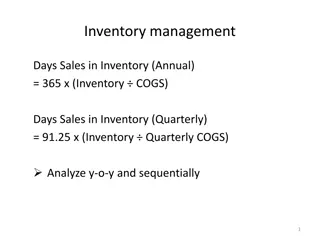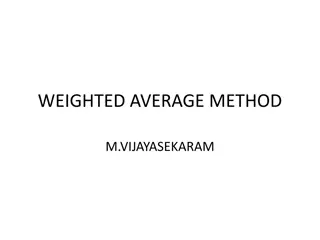Cost Calculation and Inventory Analysis for Manufacturing Companies
This content delves into the calculation of various costs and inventory data for manufacturing companies based on specific scenarios and information provided. It covers topics like direct materials inventory, manufacturing overhead costs, labor costs, finished goods inventory, and more, offering a detailed analysis and computations for each aspect.
Download Presentation

Please find below an Image/Link to download the presentation.
The content on the website is provided AS IS for your information and personal use only. It may not be sold, licensed, or shared on other websites without obtaining consent from the author. Download presentation by click this link. If you encounter any issues during the download, it is possible that the publisher has removed the file from their server.
E N D
Presentation Transcript
Ex 1 Flow of Inventor able Costs Ranks,Heaters S elected data for October 2016. Direct materials inventory 10/1/2016 105000 $ Direct materials purchased 364000 $ Direct materials used 385000 $ Total manufacturing overhead costs 450000 $ Variable manufacturing overhead costs 265000 $ Total manufacturing costs incurred during October 2016 1610000 $ Work- in process inventory 10/1/2016 230000 $ Cost of good manufactured 1660000 $ Finished good inventory 10/1/2016 130000 $ Cost of good sold 1770000 $
Calculate the following Costs: Direct materials inventory 10/31/2016. Fixed manufacturing overhead costs. Direct manufacturing labor Costs for 1. 2. 3. October 2016. Work- in process inventory 10/1/2016. Cost of finished good available for sale in 4. 5. October 2016. Finished good inventory 10/31/2016. 6.
EX2 For the previous month (march 2016) Ron was able to piece together the following information : Direct materials purchased Work- in process inventory 3/1/2016 Direct materials inventory 3/1/2016 Finished good inventory 3/1/2016 240000 $ 70000 $ 25000 $ 230000 $ 660000 $ 840000 $ Conversion Cost Total manufacturing costs added during the period Cost of good manufactured Gross margin as a percentage of revenues Direct materials used 20 % Revenues 1037500 $ Calculate the Cost of: Finished good inventory 3/31/2016. Work- in process inventory 3/31/2016. Direct materials inventory 3/31/2016. 1. 2. 3.
EX3 Direct and absorption costing ,During the past year , Morgan Company produced 15000 units (100% of normal capacity) of a product and sold 120000 of these units production costs consisted of 300000$ direct materials ,375000 $ direct labor, 150000 $ variable factory overhead, and 187500 $ fixed factory overhead . Required : Using direct costing, Compute (a) the per unit cost of production and (b) the year- end inventory cost. Using absorption costing, Compute (a) the per unit cost of production and (b) the year- end inventory cost. 1) 2)
EX4 Absorption and direct costing , N Company began its operations on January 1 , 19A and produces one product that sells for $7 Normal capacity is 100000 units per year with 100000 units produced and 80000 units sold in 19A , Manufacturing costs and marketing and administrative expenses were as follows : item Fixed costs - - 150000 $ 80000 $ Variable costs 1.50 per unit produced 100 per unit produced 0.50 per unit produced 0.50 per unit sold Materials Direct labor Factory overhead marketing and administrative expenses There were no variances form the standard variable costs, Any under or over applied overhead is written off directly at year end as an adjustment to the cost of good sold . Required: 1. In presenting inventory on the December 31,19A balance sheet ,Compute the unit Cost under absorption costing. 2. Determine the 19A Operating income , using direct costing.
EX5 Income statements- absorption costing & direct costing ,The following data pertain to April Beginning inventory 0 Unit sold 5000 8000 24 $ 10 28000 3.50 10000 Units produced Sales price per unit Direct manufacturing cost per unit Fixed factory overhead- total Fixed factory overhead- per unit Commercial expense (all fixed ) Required: 1. Prepare an income statement using absorption costing. 2. Prepare an income statement using direct costing. 3. Provide computations explaining the difference in operating income between the two methods.
ECONOMIC Order Quantity EOQ EX1 Fan Base (FB) operates a megastore featuring sport merchandise, it uses an EOQ decision model to make inventory decisions, it is now considering inventory decisions for its LOS Angeles Galaxy soccer jerseys product line .This is a highly popular item .Data for 2016 are as follows:
Expected annual demand for Galaxy jerseys Ordering cost per purchase order Carrying cost per year 10000 200 $ 7 $ jersey Each jersey costs FB 40 $ and sells for 80 $, the 7 $ Carrying cost per jersey per year comprises the required return on investment of 4.80 $ (12 x 40$ purr chase price ) plus 2.20 $ in relevant insurance , handling , and theft related costs ,the purchasing lead time is 7 days .FB is open 365 days a year. Required : 1. Calculate the EOQ. 2. Calculate the number of orders that will be placed each year. 3. Calculate the reorder point.
EX2 The Denim World sells fabric to a wide range of industrial and consumer users one of the products it carries is denim cloth, used in the manufacture of jeans and carrying bags, The supplier for the denim cloth pays all incoming freight , No incoming inspection of the denim is necessary because the supplier has a track record of delivering high- quality merchandise, the Denim World has collected the following information :
Annual demand for denim cloth Ordering cost per purchase order Carrying cost per year Safety- Stock requirements Cost of denim cloth 26400 yards 165 $ 20% of purchase costs None 9 $ per yard The purchasing lead time is 2 week .The Denim World is open 250 day a year ( 50 week for 5 days a week). Required : (a)Calculate the EOQ for denim cloth. (b)Calculate the number of orders that will be placed each year. (c)Calculate the reorder point for denim cloth.
1. Maximum Stock level 2. Minimum Stock level 3. Re-ordering level 4.Average Stock level. Normal Consumption 600 unit per week Maximum Consumption 840 unit per week Minimum Consumption 480 unit per week Re-ordering quantity 7200 unit Re-ordering period 10 to 15 week Normal reorder period 12 week
EX 4 The following information available in respect of a material X: Re-ordering quantity Maximum Consumption Minimum Consumption Normal Consumption Re-ordering period 1800 unit 450 unit per week 150 unit per week 300 unit per week 3 to 5 week calculate the following: (a) Re-ordering level (b) Minimum Stock level (c) Maximum Stock level.
EX 5 Tow Components P,Q are used as follows, Normal usage 1000 unit per week each , Re-ordering quantity P 20000 ; Q 8000 , Re-ordering period P 4 to 6 week ; Q 2 to 4 ; Minimum usage 2000 unit per week ; each Maximum usage 3000 unit per week each. You are required to calculate the following each of the Components: Minimum Stock level. Maximum Stock level. Average Stock level. Re-ordering level. 1. 2. 3. 4. EX 6 From the following information for last twelve month, compute the Re-order level. Minimum level. Maximum level. Average Stock level for the Components of X and Y (1) (2) (3) (4)
Components item X Y Maximum Components in a month 3000 3000 Minimum Components in a month 2000 2000 Average Components in a month 1000 1000 Re-order period in a month 8 to 12 4 to 8 Re-order quantity in units 8000 12000






